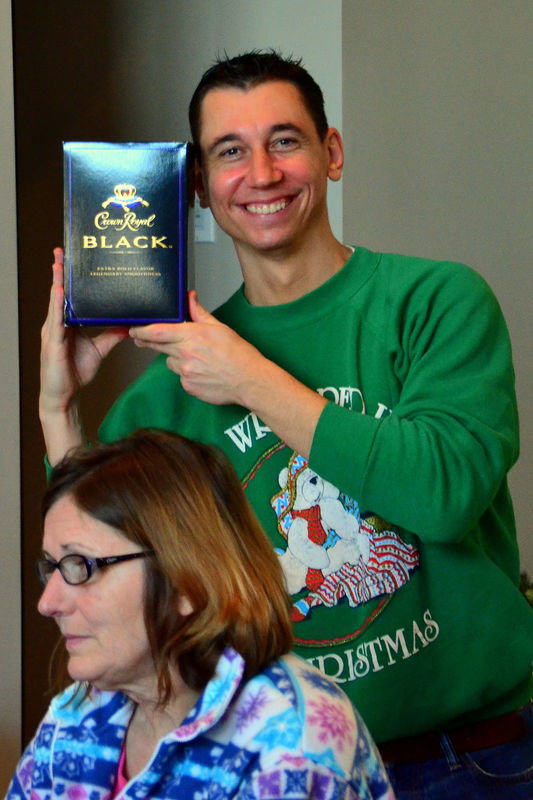Nikon D750 Auto ISO
Dec 27, 2014 11:52:31 #
Shutter Bugger wrote:
The lens you used is pretty "slow" and apart from that, Ken Rockwell puts it in the list of the "Top 10 Worst Lenses" Nikon has produced.
You are confusing the newer (2010) 24-120mm f/4 lens with the older 24-120mm f/3.5-5.6 lens. The f/4 version made the list of lenses suitable for the D800(E), and will certainly do very well on a D750.
Dec 27, 2014 11:58:11 #
Cameralark
Loc: Torrington, CT
The lower limit when using auto ISO is determined by where you have ISO set manually. You may have inadvertently set your ISO to 8000 in which case that will prevail. When shooting on auto ISO you should keep your manual setting at 100. Then you can experience the entire range of ISO possibilities.
Dec 27, 2014 12:04:31 #
PCity wrote:
Probably way off base, but even though though you are in ISO Auto, what do you have your ISO set at? I think it could have an affect on the ISO in affect at the time the picture is taken???
This is a good point, and something that trips up folks often.
The camera's setting for ISO is in effect the lower limit for Auto ISO. No matter how much light, Auto ISO will not go higher.
On the high end I've always found the easiest way to notice an out of range condition is to set the maximum one step higher than I actually want to use. Then I watch what Auto ISO sets and know that when it says it at that maximum it might actually be there, and it also might be seriously under exposed too! But if it sets ISO one step below the max, then it is within the range where Auto ISO can adjust it and won't be underexposed. I find that easier than noticing when the little indicator blinks. For my brain it's just more intuitive.
Dec 27, 2014 12:13:56 #
Checking my camera, while pressing the ISO button on the back of the camera, the ISO Auto is set at 100, Auto ISO Sensitivity control is ON, ISO Sensitivity is set to 100.
In the Photo Shooting menu, ISO Sensitivity Settings: Auto ISO sensitivity is ON, Max sensitivity is 8000, Minimum shutter speed set to Auto. ISO Sensitivity is 100.
In the Photo Shooting menu, ISO Sensitivity Settings: Auto ISO sensitivity is ON, Max sensitivity is 8000, Minimum shutter speed set to Auto. ISO Sensitivity is 100.
Dec 27, 2014 12:32:39 #
thively61 wrote:
Checking my camera, while pressing the ISO button on the back of the camera, the ISO Auto is set at 100, Auto ISO Sensitivity control is ON, ISO Sensitivity is set to 100.
In the Photo Shooting menu, ISO Sensitivity Settings: Auto ISO sensitivity is ON, Max sensitivity is 8000, Minimum shutter speed set to Auto. ISO Sensitivity is 100.
In the Photo Shooting menu, ISO Sensitivity Settings: Auto ISO sensitivity is ON, Max sensitivity is 8000, Minimum shutter speed set to Auto. ISO Sensitivity is 100.
The significance of those setting is that ISO will never be set lower than 100 or higher than 8000, regardless of how much light there is. Because you are otherwise using Manual Exposure mode, and manually setting both shutter speed and aperture, the menu configured minimum shutter speed has no effect at all.
There are two problems you could experience. If there is a lot of light and ISO is at 100, you can't easily tell if that is correct or if the image will be over exposed. At the opposite end of the range if ISO is at 8000 it might be right, but it could be that ISO needs to be at 16000 to get proper exposure.
I can't remember the exact indications the camera gives when an out of range condition exists. The ISO display in the viewfinder blinks on one of them (higher ISO needed?). Whatever it is, it is something that I just never notice... But I do notice what the actual ISO is, so I always put the upper and lower limits one step past what I think is acceptable, and if either limit is actually reached I know that ISO is out of range whether it is exactly what it says it is or if it should be two stops past that. That's what works for me, and may or may not for anyone else.
Dec 27, 2014 12:53:13 #
Dec 27, 2014 13:58:16 #
Also, your "underexposed" no flash shot is easily correctable in post processing to proper brightness levels. Even if you are shooting Jpeg. If RAW, VERY easily correctable, and when corrected would look very similar to the shot at the higher "more correct" ISO. Boosting exposure in PP adds noise much as raising the ISO does.
With the D750, shots underexposed by as much as 5 or 6 stops can be exposure compensated in PP and yield good results. This is one of the benefits of the camera's outstanding dynamic range.
With the D750, shots underexposed by as much as 5 or 6 stops can be exposure compensated in PP and yield good results. This is one of the benefits of the camera's outstanding dynamic range.
Dec 27, 2014 14:02:58 #
jackpi
Loc: Southwest Ohio
When I am inside, I use a fast prime lens (50mm f/1.4) at wide aperture (f/1.4 to f/2.0) with auto-ISO and zoom with my feet. Flash is seldom necessary.
The other advantage of wide aperture is it blurs the distracting background.
The other advantage of wide aperture is it blurs the distracting background.
Dec 27, 2014 14:13:52 #
Apaflo wrote:
You are confusing the newer (2010) 24-120mm f/4 lens with the older 24-120mm f/3.5-5.6 lens. The f/4 version made the list of lenses suitable for the D800(E), and will certainly do very well on a D750.
I believe you are correct. That is why Nikon made the change to the constant f4 :thumbup: :thumbup:
Dec 27, 2014 15:06:03 #
pmackd wrote:
Also, your "underexposed" no flash shot ... (show quote)
That is almost true, but only if low quality snaps for Granny's album are the only target. Which is to say that for many people, and a new photographer, what you say can be taken as a reasonable "truth".
But on a higher level, it's not. There is no way that shot without flash can ever be processed to produce a high quality image worth hanging on the dining room wall! Basically it's physics, not the camera. The D750 has terrific dyanmic range... at ISO 100 (where by one measure the useful range is a whopping 11.3 f/stops, or more than 3 greater than any printer or a typical monitor can show), but when shooting with ISO at 8000 the dynamic range is only about 5-1/2 fstops. That means noise will be obvious, and it means that to get a good image requires very precise exposure. If exposure needs to be pulled 1 stop, the dynamic range is only 4-1/2, and so on. There simply is no way to resurrect a 5 stop under exposure.
The other problem is the poor lighting in terms of composition. Too many shadows in the wrong places and not the right angles to bring out texture in the right places. The suggestions for bounce lighting with speedlights will only help that a little, by lighting up the shadows better. But the light will at best be flat, and the pictures will lack pop.
The ultimate solution for great photography comes from studying studio lighting. Positioning lights to best show the subject. And with enough light to let the camera work at or very close to ISO 100 where it does actually have that fantastic dynamic range that can be used in post processing to do tone mapping for best effect.
Today the OP may be satisfied with relatively low quality images that the mother will like (mothers like anything). But he didn't go out and spring for a D750 with a nice lens like that 24-120mm f/4 thinking he'd never do better than a low cost P&S... Two years from now he won't let the mother even see two shots like those posted in this thread! You have to cull out the rejects before she looks at them, because once Mom knows it exist you can never delete it... When she wants to see it in 5 years, or 20 years, you better have it or a good story about what happened to it. If you just deleted it, you deleted her baby!
Dec 27, 2014 15:37:51 #
Indoors I never use a lens that is slower than 2.8 and in most cases 1.8, 50mm and let my feet do the zooming!! I have 2 D7000s and I get good results using that combo so there should be no reason that the D750 can't get the same results. I have a zoom 3.5-5.6 and gave up trying to get shots with it indoors for the most part but here are a couple I have from last X-mas using the zoom indoors---not a problem if you have decent ambient light!!
Dec 27, 2014 15:42:30 #
Yes, I love my 24-120 lens.
Maybe this a little off what the original question was but thought I'd give you what I did at Christmas. I shot 180 pictures with that lens on a D7100 using an SB-600 speed light. I set it on sutter priority using 1/60 sec, ISO 400 and let the flash bounce off the ceiling. It appears the camera used F4 for all the shots. I suppose the flash varied it's output. The pictures weren't perfect but most all had very good exposure and the bouncing light didn't create many shadows. I haven't tried many shots using available light in those circumstances but maybe I should. Just my 2 cents worth.
Maybe this a little off what the original question was but thought I'd give you what I did at Christmas. I shot 180 pictures with that lens on a D7100 using an SB-600 speed light. I set it on sutter priority using 1/60 sec, ISO 400 and let the flash bounce off the ceiling. It appears the camera used F4 for all the shots. I suppose the flash varied it's output. The pictures weren't perfect but most all had very good exposure and the bouncing light didn't create many shadows. I haven't tried many shots using available light in those circumstances but maybe I should. Just my 2 cents worth.
Peanut_the_cat wrote:
Don't take Ken Rockwell too seriously - the 24 -12... (show quote)
Dec 27, 2014 16:45:46 #
All this works if the OP understands the exposure triangle, he would then know to either adjust aperture or shutter speed to keep ISO below ISO8000. If he understood the exposure triangle we would not be having this conversation. Without knowing the basics we are speaking greek..
Apaflo wrote:
The significance of those setting is that ISO will... (show quote)
Dec 27, 2014 18:03:12 #
fstop22 wrote:
It would certainly help!! Good books and also info on google are available to help understand or go to "search" here on the Hog and there should be plenty of good info........All this works if the OP understands the exposure triangle, he would then know to either adjust aperture or shutter speed to keep ISO below ISO8000. If he understood the exposure triangle we would not be having this conversation. Without knowing the basics we are speaking greek..
Dec 27, 2014 18:21:21 #
Apaflo wrote:
If you're referring to my 2 photos, that's exactly what they are, snapshots!! That's all I take at Christmas because it's a 3 ring circus and nobody is expecting any more than snap shots. If I get a great shot that's merely frosting on the cake but for the most part it's just a fun day........That is almost true, but only if low quality snaps... (show quote)
If you want to reply, then register here. Registration is free and your account is created instantly, so you can post right away.








